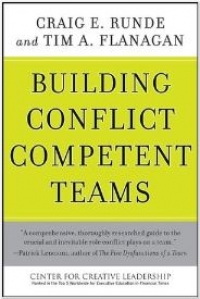Building Conflict Competent Teams
Authors: Craig E. Runde and Tim A. Flanagan
Publisher: Jossey-Bass (June 23 2008
Understanding how to cool down, slow down, and engage the naturally occurring conflicts among team members is critical to the ultimate success of a team. With this book, your team and its members will gain a deeper understanding of how conflict emerges and how to respond in ways that will leverage conflicts to their advantage. Team members will learn the importance of establishing a safe team climate, agreeing on processes to guide interactions, and use of constructive communication skills in order to develop a conflict competent team.
As the authors say, conflict is not to be avoided, but embraced and explored. This often results in new, previously unimagined opportunities, solutions and results. The authors include stories, interviews, and examples that provide entertaining and thought provoking insights. They dedicate one chapter to techniques and processes for addressing team conflict that has gone awry. Runde and Flanagan also include useful tips and tools for assessing your team?s current state of conflict competence and suggestions for addressing the challenges of today?s virtual and geographically dispersed teams.

Comments
Marie-Claude As... replied on Permalink
A rare book on conflict management
It is one rare book on managing conflict that combines both elements of "team" and "prevention"; its uses real-life examples (naming names); it focuses on building capacity of teams and their members, BEFORE conflicts arise; it has a chapter dedicated to virtual or global teams addressing some of the challenges of dealing with conflicts when your team is geographically dispersed and/or multicultural; it features practical team assessment tools.
“Team leaders and team members individually and collectively have the power to choose the way they interact and communicate with each other. When they chose wisely, the intensity of the conflict remains manageable. Differences and misunderstandings are addressed comfortably. Disagreements are met with curiosity rather than animosity. The ways team members choose to communicate essentially creates the map that conflict will follow.”